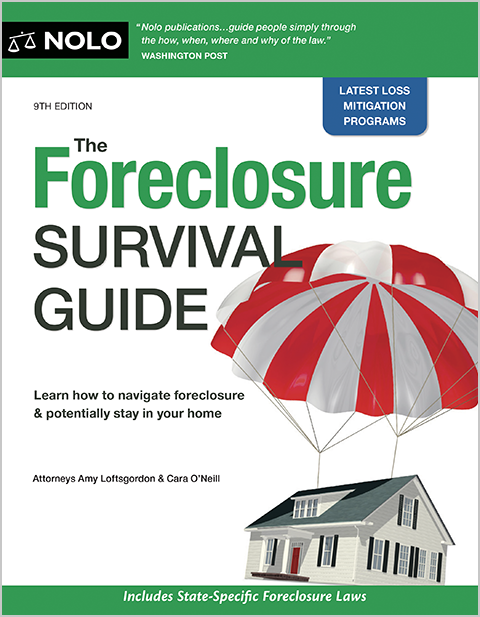What federal rules and regulations cover foreclosure? Find out here.
Federal laws protect homeowners in the foreclosure process. These laws help homeowners by ensuring loan servicers provide assistance if a borrower is having difficulty making their mortgage payments. They also protect borrowers from wrongful actions by loan servicers.
- What Are the Federal Foreclosure Laws?
- Summary of Federal Foreclosure Laws
- Early Intervention Requirements Under Federal Foreclosure Laws
- Continuity of Contact Requirements: Servicer Must Appoint Personnel to Help the Borrower
- Restrictions on Dual Tracking
- Applicability of the Federal Foreclosure Laws
- Getting Help With Avoiding Foreclosure
What Are the Federal Foreclosure Laws?
Regulation X, which implements the Real Estate Settlement Procedures Act (RESPA), requires most mortgage servicers to take certain steps and provide specific protections to borrowers facing foreclosure. The rules have rigid timing and other requirements that servicers must follow. The rules also rely on borrowers submitting all their documents before the servicer begins its review or pauses foreclosure proceedings.
These rules and regulations governing mortgage servicing went into effect in 2014. They were developed in response to the massive foreclosure crisis when millions of homes went into foreclosure between 2006 and 2014.
Summary of Federal Foreclosure Laws
Under federal law, servicers are supposed to work with borrowers who are having trouble making monthly payments by, among other things:
- contacting borrowers by phone or in-person to discuss ways to avoid foreclosure
- informing borrowers in writing about loss mitigation options that might be available
- providing a single person or a team to assist a delinquent borrower, and
- not dual tracking.
Early Intervention Requirements Under Federal Foreclosure Laws
Soon after the borrower misses a payment, the servicer must contact the borrower by phone (or in person) and in writing.
Servicer Must Contact the Borrower By Phone or In Person
If a borrower falls behind in payments, a servicer must attempt to contact the borrower to discuss the situation no later than 36 days after the delinquency and again within 36 days after each subsequent delinquency, even if the servicer previously contacted the borrower. If appropriate, the servicer must tell the borrower about loss mitigation options, like a modification, short sale, or deed in lieu of foreclosure, that might be available to the borrower.
But, if you filed for bankruptcy or asked the servicer to stop communicating with you under the Fair Debt Collection Practices Act (FDCPA), and the servicer is subject to this law, the servicer doesn't have to try to contact you by phone or in person. (12 C.F.R. § 1024.39 (2024).)
Servicer Must Contact the Borrower In Writing
No later than 45 days after missing a payment, the servicer must inform the borrower in writing about loss mitigation options that might be available and must do so again no later than 45 days after each payment due date so long as the borrower remains delinquent.
However, the servicer doesn't have to provide the written notice more than once during any 180-day period. If you've filed for bankruptcy or asked the servicer not to communicate with you, it generally has to send a modified letter, subject to some exceptions. (12 C.F.R. § 1024.39 (2024).)
Continuity of Contact Requirements: Servicer Must Appoint Personnel to Help the Borrower
The servicer must assign personnel to help the borrower by the time the borrower falls 45 days delinquent. (12 C.F.R. § 1024.40 (2024).) The personnel should be accessible to the borrower by phone and able to respond to the borrower's inquiries.
When applicable, the servicer's personnel should help the borrower pursue loss mitigation options by advising the borrower about:
- available loss mitigation programs
- how to submit a complete loss mitigation application
- the status of a submitted application
- how to appeal (if the application is denied), and
- the circumstances when the servicer may refer a file to foreclosure.
The servicer may assign a single person or a team to assist a delinquent borrower.
Restrictions on Dual Tracking
Federal law also restricts "dual tracking." Dual tracking happens when a servicer simultaneously evaluates a borrower for a loan modification (or another loss mitigation option) while at the same time pursuing a foreclosure.
Restrictions on Starting Foreclosure
Servicers generally can't start a foreclosure (that is, make the "first notice or filing" required to begin the process) until the loan obligation is more than 120 days delinquent unless the foreclosure is based on a violation of a due-on-sale clause or the servicer is joining the foreclosure action of a superior or subordinate lienholder. (12 C.F.R. § 1024.41 (2024).)
This 120-day period provides time for the borrower to submit a loss mitigation application.
When does a borrower become delinquent? A borrower is considered delinquent starting on the date a periodic payment sufficient to cover principal, interest, and, applicable, escrow becomes due and unpaid, until such time as no periodic payment is due and unpaid.
So, when can a foreclosure begin? In a judicial foreclosure, the foreclosing party can't file a lawsuit in court to start the foreclosure until you're more than 120 days delinquent. If the foreclosure is nonjudicial, the foreclosing party can't begin the foreclosure by recording or publishing the first notice until you're more than 120 days delinquent on payments. If your state's foreclosure laws don't require a court filing or any document to be recorded or published as part of the foreclosure process, the first notice is the earliest document that establishes, sets, or schedules a date for a foreclosure sale.
See Nolo's Key Aspects of State Foreclosure Law: 50-State Chart to learn how foreclosure works in your state.
Further Restrictions on Starting a Foreclosure
Even if a borrower is more than 120 days delinquent, if that borrower submits a complete loss mitigation application before the servicer makes the first notice or filing required to initiate a foreclosure process, the servicer can't start the foreclosure process unless:
- the servicer informs the borrower that the borrower is not eligible for any loss mitigation option, and any appeal has been exhausted
- the borrower rejects all loss mitigation offers, or
- the borrower fails to comply with the terms of a loss mitigation option such as a trial modification. (12 C.F.R. § 1024.41 (2024).)
Restrictions on Continuing Foreclosure After the Borrower Requests Help
If the servicer has already started a foreclosure and receives a borrower's complete loss mitigation application more than 37 days before a foreclosure sale, the servicer may not move for a foreclosure judgment or order of sale, or conduct a foreclosure sale, until one of the three conditions mentioned above has been satisfied.
The servicer generally doesn't have to review more than one loss mitigation application from you. But if you bring the loan current after submitting an application and then reapply, the servicer must consider your new application. (12 C.F.R. § 1024.41 (2024).)
Applicability of the Federal Foreclosure Laws
These laws apply to mortgage loans that are secured by a property that is the borrower's principal residence. The principal residence status determination depends on the property's specific facts and circumstances and applicable state law.
A vacant property might still be a borrower's principal residence under certain circumstances. For example, when a servicemember who relocated due to a permanent change of station orders and was living at the property as a principal residence immediately before displacement intends to return to the property in the future and doesn't own any other residential property.
In most cases, the laws don't apply to:
- HELOCs and other open-end lines of credit
- small servicers (see below)
- reverse mortgage transactions, and
- loans for which the servicer is a qualified lender under the Farm Credit Act of 1971. (12 C.F.R. § 1024.30 (2024).)
What Is a Small Servicer?
A "small servicer" is defined as one that:
- together with any affiliates, services 5,000 or fewer mortgage loans, and the servicer (or an affiliate) is the creditor or assignee for all of them, or
- is a Housing Finance Agency, which is a government agency established to help meet the affordable housing needs of the residents of their states.
Which Laws Don't Apply to Small Servicers?
Small servicers don't have to comply with the requirements previously discussed in this article, except:
- A small servicer can't start a foreclosure unless the borrower is more than 120 days delinquent (again, unless the foreclosure is based on a violation of a due-on-sale clause or the servicer is joining the foreclosure action of a superior or subordinate lienholder).
- A small servicer can't proceed to foreclosure judgment or get an order of sale, or conduct a foreclosure sale, if a borrower is performing under the terms of a loss mitigation agreement. (12 C.F.R. § 1024.41 (2024).)
Getting Help With Avoiding Foreclosure
If you're having trouble making your mortgage payments, consider submitting a loss mitigation application to your loan servicer. Once submitted, under federal law, the servicer has five days to tell you whether it needs more information so long as you submit the application 45 days or more before a foreclosure sale and, if so, what information it needs.
Generally, the servicer is required to evaluate the application for all loss mitigation options within 30 days, as long as you submit the complete application more than 37 days before a foreclosure sale.
Also, you generally get 14 days to appeal a loan modification denial as long as the servicer received the complete loss mitigation application 90 or more days before a scheduled foreclosure sale. If a complete loss mitigation application is received less than 90 days before a foreclosure sale but more than 37 days before a foreclosure sale, the servicer must give you at least seven days to accept or reject a loss mitigation offer. Remember, the servicer is required to review you for a loss mitigation option only once unless you bring the loan current after submitting your complete application.
If you have questions about your state's foreclosure process or the laws discussed in this article, consider talking to a foreclosure attorney.
Consider contacting a HUD-approved housing counselor to learn about different loss mitigation options or if you need help with your application.
- What Are the Federal Foreclosure Laws?
- Summary of Federal Foreclosure Laws
- Early Intervention Requirements Under Federal Foreclosure Laws
- Continuity of Contact Requirements: Servicer Must Appoint Personnel to Help the Borrower
- Restrictions on Dual Tracking
- Applicability of the Federal Foreclosure Laws
- Getting Help With Avoiding Foreclosure

